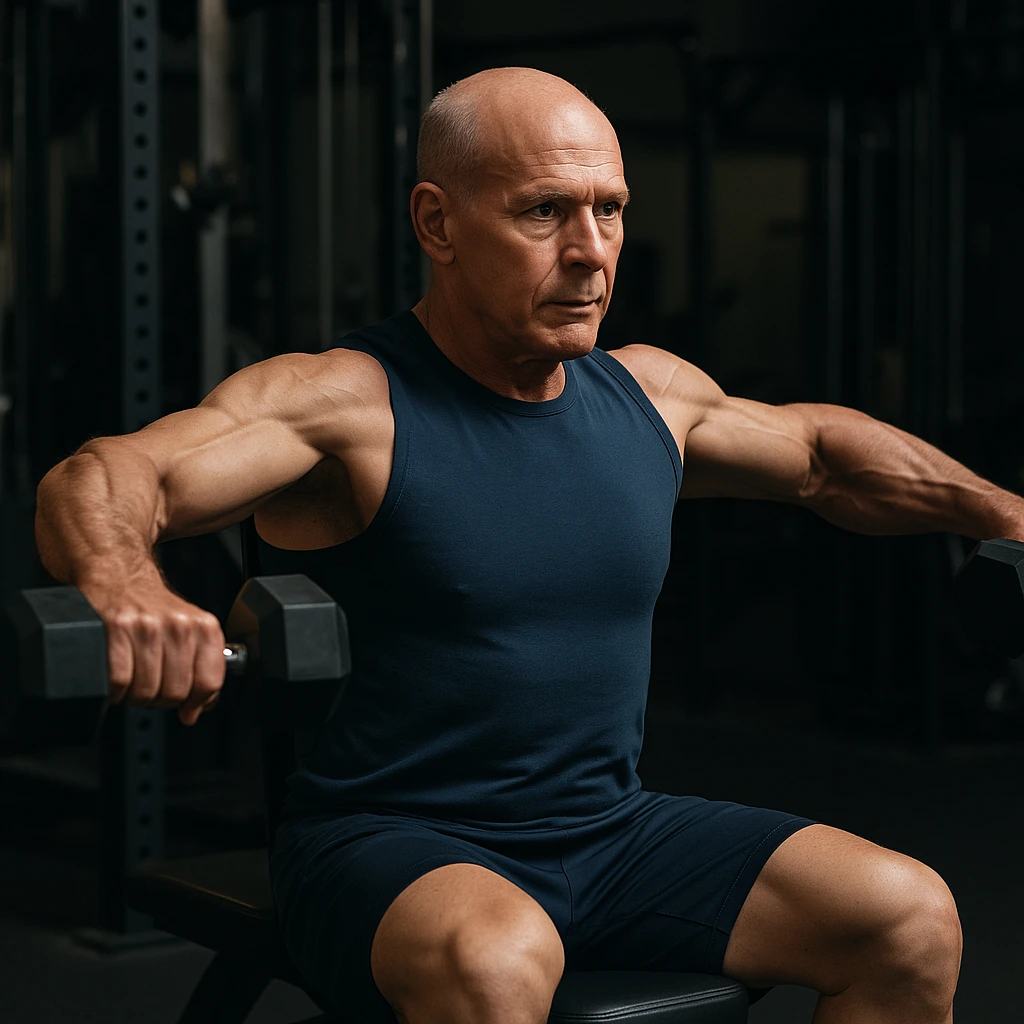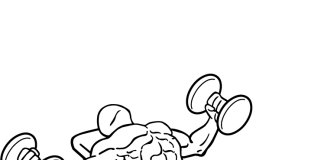Last Updated on September 25, 2025
If you’ve been lifting for decades, then took a long break, you know it’s not easy to get your physique back to where it was. You are in your 50s, after seven years away from the gym, building your delts again can feel like an uphill battle. But here’s the good news: muscle memory is real. With the right approach, your delts can come back stronger, fuller, and rounder than ever—without wrecking your joints.
This guide lays out a 12-week progression plan specifically designed for lifters over 50 who want to rebuild their shoulders. We’ll focus on compound presses, targeted isolation, safe volume, and joint-friendly techniques. By the end of 12 weeks, you’ll see noticeable size, strength, and shape in your delts.
Why Shoulders Are Tough to Build (Especially After 50)
The deltoids (shoulders) are made up of three heads:
- Anterior deltoids (front) – heavily used in pressing exercises.
- Lateral deltoids (side) – the “cap” of the shoulder that creates width.
- Posterior deltoids (rear) – key for posture and balance, often neglected.
Here’s the challenge:
- The front deltoids get plenty of work from bench presses and push-ups, so they often overpower the side and rear delts.
- The side and rear deltoids need isolation work, but they don’t respond well to heavy weights and sloppy form.
- At 55, joint recovery is slower—your tendons and rotator cuff need careful attention.
That’s why this program balances pressing strength with high-volume isolation work, with a gradual build-up in intensity.
Training Principles for Deltoids at 55+
Before jumping into the program, keep these principles in mind:
- Frequency: Train shoulders twice per week for growth.
- Moderate weights, higher reps: Delts thrive on 10–15 reps with controlled form.
- Tempo matters: 2–3 seconds lowering the weight creates more growth stimulus.
- Don’t overload joints: Save the heavy work for presses; keep lateral/rear delt work light and strict.
- Recovery is king: Stretch, sleep, and fuel your body with enough protein.
The 12-Week Deltoid Progression Plan
We’ll break this down into three 4-week phases. Each phase builds on the last—starting with foundation work, then pushing strength, and finally finishing with specialization and pump volume.
Phase 1 (Weeks 1–4): Foundation & Activation
Goal: Rebuild strength base, activate lateral and rear delts.
Workout A (Compound Focus)
- Seated Overhead Dumbbell Press – 4×8–10
- Dumbbell Lateral Raises – 4×12–15
- Cable Face Pulls – 3×15
- Rear Delt Fly (machine or dumbbells) – 3×12–15
Workout B (Isolation/Volume Focus)
- Standing Overhead Barbell Press – 4×8
- Cable Lateral Raises – 4×12–15
- Rear Delt Cable Fly – 4×12–15
- Upright Rows (EZ bar, light) – 3×10–12
👉 In this phase, keep weights moderate. Focus on feeling the delts working, not just moving the weight.
Phase 2 (Weeks 5–8): Strength & Growth
Goal: Increase load, build density, add intensity techniques.
Workout A
- Seated Overhead Dumbbell Press – 5×6–8 (heavier)
- Dumbbell Lateral Raise + Drop Set – 4×10–12 + drop to failure
- Cable Face Pulls – 4×12–15
- Rear Delt Rows (incline bench, dumbbells) – 3×10–12
Workout B
- Push Press (with slight leg drive) – 4×6–8
- Cable Lateral Raises – 5×12–15
- Rear Delt Cable Fly – 4×12–15
- Dumbbell Front Raise (alternate arms) – 3×12
👉 Start using drop sets, slow negatives, and partial reps here to push growth without going too heavy.
Phase 3 (Weeks 9–12): Specialization & Peak
Goal: Maximize pump, polish side/rear delts, and finish with high-volume challenges.
Workout A
- Arnold Press – 4×8–10
- Dumbbell Lateral Raise (rest-pause method) – 4 sets
- Reverse Pec Deck – 4×12–15
- Barbell Upright Rows (close grip) – 3×8–10
Workout B
- Standing Overhead Barbell Press – 5×6
- Cable Lateral Raise (one arm at a time) – 4×12–15
- Rear Delt Fly (dumbbell, incline bench) – 4×12–15
- Face Pulls (rope) – 3×15–20
Shoulder Shock Finishers (1x per week)
- 100-Rep Lateral Raise Challenge
- Use very light dumbbells, rest as needed until you reach 100 reps.
- Giant Set: Side raise → Front raise → Rear raise, 10 reps each, no rest, repeat 3 times.
👉 These finishers create massive metabolic stress and bring detail and roundness to your shoulders.
Rotator Cuff Prehab (Do Before Every Session)
Your shoulders will only grow if your joints are healthy. At 55, you can’t skip this step. Spend 5 minutes before every workout doing:
This keeps your rotator cuff strong and prevents nagging injuries.
Nutrition & Recovery for Delt Growth
Training is only half the battle. At 55, you need to support recovery:
- Protein intake: Aim for 1.6–2.0 g/kg of bodyweight daily.
- Healthy fats: Omega-3s reduce inflammation (fish, walnuts, flaxseed).
- Sleep: 7–9 hours is non-negotiable for recovery.
- Hydration: Muscles need fluid balance to function optimally.
- Active recovery: Walks, mobility drills, and stretching will speed up recovery between sessions.
Final Thoughts
Rebuilding your delts at 55 isn’t about ego lifting or chasing numbers. It’s about consistency, progression, and respecting your joints.
This 12-week delt specialization program gives you the structure and strategy to bring back round, powerful shoulders. By focusing on lateral and rear delts, balancing strength with pump work, and supporting your recovery with proper nutrition and joint care, you’ll see real changes by the end of the program.
✅ Bookmark this program.
✅ Watch the linked YouTube demos before trying each move.
✅ Track your lifts and aim for small, steady improvements.
Remember: you don’t need to train like you did at 30—you need to train smarter. And when you do, your delts will show it.







